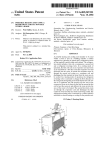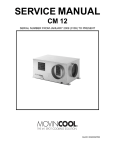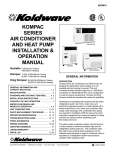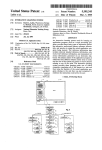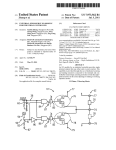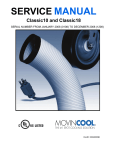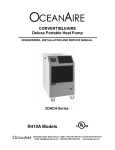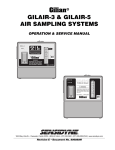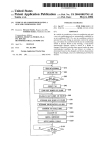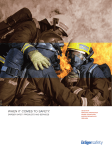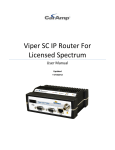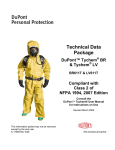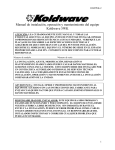Download Portable cooling and heating unit using reversible refrigerant circuit
Transcript
US006167714B1 (12) United States Patent (10) Patent N0.: (45) Date of Patent: Baffes US 6,167,714 B1 Jan. 2, 2001 (54) PORTABLE COOLING AND HEATING UNIT Heat Exchangers, Inc., Koldwave Engineering Installation USING REVERSIBLE REFRIGERANT CIRCUIT & Service Manual, undated—admitted prior art. Air Rover, downloaded pages from Internet website, undated—admitted prior art. The Applied Companies, downloaded pages from Internet (75) Inventor: Peter Ba?'es, Skokie, IL (US) (73) Assignee: DO Enterprises, LLC, Chicago, IL (*) Notice: website, Sep. 2, 1998. (Us) The Avenger Series, downloaded pages from Internet web Under 35 U.S.C. 154(b), the term of this patent shall be extended for 0 days. J ainsons Aircon, downloaded pages from Internet website, site, Sep. 2, 1998. Sep. 2, 1998. (21) Appl. No.: 09/497,956 (22) Filed: (List continued on neXt page.) Feb. 4, 2000 Primary Examiner—William Doerrler Assistant Examiner—Marc Norman Related US. Application Data (63) Continuation of application No. 09/190,508, ?led on Nov. 12, 1998. (51) Int. Cl.7 .................................................... .. F25D 17/02 (74) Attorney, Agent, or Firm—Rockey, Milnamow & KatZ, Ltd. (57) ABSTRACT A portable heating and cooling unit intended to be used within a room or area of a building includes a cabinet (52) us. Cl. ........................ .. 62/188; 62/324.1; 62/324.5; 62/448 (58) Field of Search ............................ .. 62/288, 188, 448, 62/196.4, 3241, 324.5 supported on a plurality of wheels and a refrigeration circuit at least partially carried within said cabinet. The refrigera tion circuit includes a ?rst coil, a compressor, a second coil and a refrigerant reversing valve. In a cooling mode of operation, the ?rst coil acts as an evaporator coil and room (56) References Cited U.S. PATENT DOCUMENTS 3,777,506 4,441,335 12/1973 Hergatt et al. . * 4,450,900 4,888,958 4,901,538 4/1984 Bonne ............................... .. 62/3246 5/1984 Nathan . 12/1989 Ella. 2/1990 Anthony. 5,031,690 7/1991 Anderson et al. . 5,729,985 * 3/1998 Yoshihara et al. ..................... .. 62/81 5,762,129 6/1998 Elliott. 5,794,452 8/1998 Black et al. . air is circulated by a ?rst fan across the evaporator coil and delivered into the room. A second fan circulates room air through the second coil acting as a condenser coil and discharges the thus warmed air away from the room area to be cooled. In a heating mode of operation, the refrigerant reversing valve is activated to change the ?ow direction of the refrigerant through the circuit such that the ?rst coil now acts as a condenser and the second coil now acts as the evaporator. Room air is drawn by the ?rst fan across the ?rst coil to heat the room air and delivery the room air into the area of the room to be heated. The second fan draws room air through the evaporator coil and discharges the thus OTHER PUBLICATIONS cooled air away from the area of the room being cooled. The OceanAire, Inc., Engineering, Installation and Service Manual, Aug. 1, 1998. OceanAire, AirBoss advertising sheet, undated—admitted prior art. refrigerant reversing valve is activated by a control which is selectable to choose heating or cooling for the portable unit. 24 Claims, 3 Drawing Sheets US 6,167,714 B1 Page 2 OTHER PUBLICATIONS Kornfort Industries, Inc., downloaded pages from Internet website, Sep. 2, 1998. Koldwave, downloaded pages from Internet website, Sep. 2, Ranco, pp. 28 through 35 from technical manual, undated— adrnitted prior art. Parker, Installation Instructions for Model A Constant Pres sure Expansion Valve, undated—adrnitted prior art. 1998. Pinguino, downloaded pages from Internet website, Sep. 2, 1998. Micro Air Corporagtion, FX—MaXX Operations Manual, Jan. 2, 1998. Movincool Products, downloaded pages from Internet web site, Sep. 2, 1998. * cited by eXarniner U.S. Patent FIG. 1 30 Jan. 2, 2001 Sheet 1 013 US 6,167,714 B1 U.S. Patent Jan. 2, 2001 Sheet 2 013 FIG. 3 US 6,167,714 B1 U.S. Patent Jan. 2, 2001 Sheet 3 013 FIG. 4 US 6,167,714 B1 US 6,167,714 B1 1 2 PORTABLE COOLING AND HEATING UNIT USING REVERSIBLE REFRIGERANT CIRCUIT for heating or cooling. The cabinet also houses fans for draWing room air into the cabinet to be heated or cooled by This is a continuation application of US. patent appli cation Ser. No. 09/190,508, ?led Nov. 12, 1998, entitled evaporation or condensing of the refrigerant in the second the ?rst coil and returned to the room, and for draWing room air (heat exchange air) into the cabinet for causing either coil Wherein the thus cooled or Warm room air is ducted PORTABLE COOLING AND HEATING UNIT USING REVERSIBLE REFRIGERANT CIRCUIT. TECHNICAL FIELD OF THE INVENTION 10 The present invention relates to a portable heating and cooling unit for use in localiZed and temporary cooling and aWay (or directed aWay) from the area being cooled or heated. The cabinet is mounted on caster Wheels to be portable Within a building or other structure. The discharged heat exchange air, either Warm air or cool air, can be ducted by a ?exible duct to outside of the room being heated or cooled. heating requirements in buildings, Warehouses, computer In contrast to prior knoWn portable cooling units, the rooms, and the like. Particularly, the present invention relates to a portable heating and cooling unit using a refrigerant circuit, and Which is mounted in a cabinet sup present invention includes a reversible refrigerant circuit for 15 selectively sWitched to change the unit service from cooling to heating, and the reverse. By reversing the refrigerant’s ?oW, the ?rst coil and the second coil effectively sWitch ported on Wheels. BACKGROUND OF THE INVENTION 20 services from evaporator to condenser, or vice versa. By reversing the services of the ?rst and second coils during a sWitch from cooling to heating service, or vice versa, the ?rst coil can alWays serve as the room air treating coil While the second coil can alWays serve as the heat exchange air coil. 25 In this regard, the discharged heat exchange air from the Portable cooling units are knoWn Which are used in localiZed cooling and heating applications in of?ce buildings, Warehouses, computer rooms and the like. The portable cooling units are held Within a cabinet Which in turn is mounted on caster Wheels for mobility. The cooling unit can be placed in near proximity to a particular location Which is otherWise not adequately served by the central cooling system of the building or other enclosure. The portable cooling unit can be used to economiZe on cooling supply in a large structure if only small areas need precise cooling control or extra cooling capacity. Portable cooling units are useful in localiZed cooling second coil can be ducted aWay from the area served by a single duct for both alternate heating and cooling periods. Neither the cabinet or the duct need be reversed or reducted 30 Within a room. The cooling units include a refrigeration circuit Which typically includes an evaporator coil, a compressor, a condenser coil and a pressure reducing or 35 expansion valve in a closed circuit containing Freon or other One or more condensate drip pans are arranged beloW both the ?rst and second coils. Although a single drip pan can be located beloW both coils, preferably one drip pan is located beloW each coil. In accordance With the preferred embodiment cabinet arrangement, the ?rst coil, Which serves for alternately heating or cooling room air to be delivered condensate collection tank, and any condensate collected in the ?rst drip pan drains by gravity into the condensate 40 room air across the condenser coil to condense the refrig erant therein. During condensing of the refrigerant, the second stream of room air is heated and the thus Warmed air is directed aWay from the room area being cooled such as via an exhaust duct. In some cases the Warmed air can be 45 discharged simply in a direction aWay from the cabinet aWay from the area to be cooled, or can be ducted to the central collection tank. A second drip pan for the second coil is arranged at a position loWer than the condensate collection tank. Acondensate pump is provided in the second drip pan located beloW the second coil to pump condensate into the condensate collection tank from the second drip pan. The condensate collection tank can include an automatic shut off system Wherein, When the condensate level reaches a maximum in the collection tank, the refrigeration circuit is shut doWn. The condensate collection tank can be drained cooling system return air supply, or to outside of the continuously by a hose connection to a room drain, or can building. In some portable cooling units, an electric heating circuit is provided for those occasions When extra heating capacity, for alternate heating or cooling periods. into the room, has a ?rst drip pan Which is elevated from a suitable refrigerant. During cooling operation, such a cool ing unit draWs a ?rst stream of room air past the evaporator coil to cool the air, and passes the thus cooled air back into the room. The cooling unit also draWs in a second stream of alternately cooling or heating room air. The refrigerant circuit has a refrigerant ?oW reversing valve that can be 50 be drained intermittently by manual drain, for example, by removal of the condensate collection tank and draining of the condensate collected therein. The ?rst coil Will typically rather than cooling capacity, is needed. The heating circuit generate condensate during a cooling operation of the unit, typically consists of an electric resistance coil Wherein a fan While the second coil Will generate condensate during a circulates room air across the coil to heat the air and pass the 55 heating operation of the unit. air back into the room. According to the invention, an electrical resistance heater is no longer required for the alternate heating mode of the SUMMARY OF THE INVENTION portable heating and cooling unit. The portable heating and The present invention contemplates a portable cooling and heating unit Which includes a reversible refrigerant cooling unit can thus be ef?ciently operated as a cooler or a 60 circuit to alternately provide either cool air or Warm air to a room or area of a building. The portable unit includes a apparatus Which effectively heats and cools localiZed areas Within a building, Warehouse, computer room and the like. cabinet Which houses a refrigerant circuit including a ?rst coil and a second coil, a compressor, and valving and accessories to complete the refrigerant circuit. The ?rst coil and the second coil can each alternately serve as evaporator or condenser, depending on Whether the unit is being used heater by manually reversing the refrigerant circuit. The portable heating and cooling unit is a compact and portable 65 It can be quickly changed in operation from cooling to heating by controls applied onto a front surface of the cabinet. Condensate produced during either a heating or cooling operation is effectively contained Within one or US 6,167,714 B1 3 4 more drip pans, and stored in a condensate collection tank for continuous or intermittent disposal. FIG. 3 illustrates in schematic fashion the components of the heating and cooling unit 20 of the invention. FIG. 3 illustrates the unit 20 in a cooling mode of operation. A refrigerant circuit includes a ?rst coil 44, a compressor 46, a second coil 48, a bidirectional, ?xed ori?ce refrigerant ?oW control 50, and a refrigerant ?oW reversing valve 52. A Numerous other advantages and features of the present invention Will become readily apparent from the following detailed description of the invention and the embodiments thereof, from the claims and from the accompanying draW compressor accumulator 54, a bidirectional refrigerant dryer 1ngs. 56, and a hot gas bypass regulator 58 are also included in the BRIEF DESCRIPTION OF THE DRAWINGS FIG. 1 is a front perspective vieW of a portable heating 10 60 and a heat exchange air fan 62. The room air delivery fan and cooling unit of the present invention; 60 draWs air A1 through the air delivery inlet grille 27, FIG. 2 is a rear perspective vieW of the portable heating and cooling unit of FIG. 1; FIG. 3 is a schematic layout of the portable heating and cooling unit of the present invention, in a cooling mode of refrigerant circuit. The refrigerant circuit is charged With a refrigerant such as R22 refrigerant. Air handling equipment includes a room air delivery fan 15 across the ?rst coil 44 and through the air delivery outlet grille 26 and into the room. The exhaust fan 62 draWs air A2 through the heat exchange air inlet grille 36, across the second coil 48, and operation; and through the heat exchange outlet 38, through the duct 40 and FIG. 4 is a schematic layout of the portable heating and cooling unit of the present invention, in a heating mode of to a position outside of the room or at least aWay from the air stream A1. operation. In the cooling mode of operation, the refrigerant ?oW circulates in the tubing as per the arroWs shoWn in FIG. 3. The ?rst coil 44 serves as an evaporator coil, evaporating the DETAILED DESCRIPTION OF THE PREFERRED EMBODIMENTS While this invention is susceptible of embodiment in many different forms, there are shoWn in the draWings and Will be described herein in detail speci?c embodiments thereof With the understanding that the present disclosure is refrigerant by removing heat from the room air A1 passing 25 across the coil 44 and thus cooling the room air Which passes through the inlet grille 27 and out of the delivery outlet grille 26 and into the room. The second coil 48 serves as a condenser coil, and air A2 to be considered as an exempli?cation of the principles of the invention and is not intended to limit the invention to the draWn through the second coil by the exhaust fan 62 is speci?c embodiments illustrated. FIGS. 1 and 2 illustrate a portable heating and cooling During this cooling operation, condensate may form on the unit 20 of the present invention. The unit includes a cabinet 22 mounted on four caster Wheels 24. The cabinet 22 includes a front panel 23, a rear panel 25, and tWo side panels 35, 37. Either or both of the side panels 35, 37 are removable to perform maintenance or service on the unit 20. The cabinet includes a room delivery air outlet grille 26 angled upWardly on a front side of the cabinet. The unit also includes a delivery air inlet grille 27 on a front side of the heated as a refrigerant is condensed Within the coil 48. 35 evaporator coil 44, and Within a chamber 68 Which is in contact With the air A1, from moisture contained in the room air. This condensate is collected in a ?rst condensate drip pan 70. A chamber drip de?ector 69 directs condensate to the ?rst drip pan 70. Condensate from the coil 44 falls by gravity into the pan 70. The drip pan 70 includes a gravity drain 72 and a drain line 74 Which feeds into a condensate collection tank 76. The condensate collection tank 76 can be designed for cabinet. ApoWer cord 28 is provided for connecting the unit hand removal, through the access door 33 (shoWn in FIG. 2), to a source of electrical poWer. A condensate tank access for periodic draining, or can have a drainage hose connected door 33 is provided on the side panel 35 of the cabinet. thereto for continuous draining. The collection tank 76 The unit includes a control 30 Which incorporates an electronic thermostat 34 and associated displays and select 45 able controls. The control 30 can be, for example, a MICRO AIR, Model FX Maxx controller, supplied by Micro Air Corporation of AllentoWn, N]. This control alloWs for both automatic and manual operation of both refrigeration cir includes an automatic sWitch 77 Which deactivates the unit 20 When condensate level in the tank 76 is at a preselected maximum condensate level. As an alternative, a condensate pump can replace the tank 76, the condensate pump receiv ing condensate from the drip pan 70 and pumping the condensate to a discharge location at a distance from the unit temperature and moisture can be monitored and the unit 20. The compressor 46 is then shut off, shutting doWn the refrigerant circuit. The fans 60, 62 can be shut doWn also. During a heating operation as shoWn in FIG. 4, the ?rst operated accordingly. coil 44 serves as a condenser, and the second coil 48 serves cuits and fan equipment. The control can provide for auto matic sWitching betWeen cooling and heating modes. Room On a back side of the cabinet 22 is a heat exchange air inlet grille 36 for draWing heat exchange air into the cabinet 55 22. A heat exchange air outlet 38 is located on a top side of as the evaporator. The How of refrigerant is reversed by operation of the refrigerant ?oW reversing valve 52. Air A1 passing through the ?rst coil 44 is heated, and thus Warm air the cabinet and can be connected to a ?exible duct 40 for is delivered to the room from the delivery outlet grille 26. exhausting heat exchange air to a position outside of the room being heated or cooled. The duct 40 can be connected Air A2 passing through the second coil 48 is cooled, delivering cool air out of the heat exchange air outlet 38 and to an air-to-outside vent through a Wall or WindoW, or through the duct 40 aWay from the air stream A1. connected to a return air duct 39 of the building central The reversal of the refrigerant reversing valve 52 is actuated by the control 30 either manually, or automatically heating and cooling system, typically an overhead duct as shoWn in FIG. 3. A plate or plenum 41 restraining an open end 42 of the duct 40 can be fastened to a top panel 43 of the cabinet 22. The open end 42 of the duct Would be in registry With the air outlet 38. Plenums, ducts, noZZles and other air handling convenience items can also be added. based on room temperature. The reversing valve itself can be, for example, a RAN CO reversing valve (3-Way or 4-Way 65 pilot design) With a Ranco L-27 or L-30 solenoid coil. It is possible that during heating mode of operation, especially When the unit is operated in a cold environment, US 6,167,714 B1 6 5 the service of said second coil from being a condenser coil to being an evaporator coil. that the temperature of the air A2 passing across the evapo rator coil 48 is lowered to such an extent that condensed Water vapor on the evaporator coil 48 is frozen on the coil. 2. The portable heating and cooling unit according to This reduces the overall efficiency of the unit by decreasing claim 1, Wherein said cabinet is supported on a plurality of the heat transfer coefficient of the coil. To alleviate this problem, a controlled amount of hot gas can be bypassed by the hot gas bypass regulator 58 from the compressor 46 into caster Wheels for rolling transport of said portable heating and cooling unit. 3. The portable heating and cooling unit according to claim 1, further comprising a condensate collection pan arranged beneath at least one of said ?rst and second coils. an inlet of the evaporator coil 48, to prevent frosting by excessively loW evaporator temperatures. The hot gas bypass regulator can be a refrigerant pressure controlled 10 expansion valve, supplied by Parker Hanni?n Corporation of LongWood, Fla. This valve is normally spring-loaded closed. HoWever, the spring is so arranged that if the outlet pressure of the valve drops beloW a preset pressure the valve 5. The portable heating and cooling unit according to 15 rator at a sufficiently high temperature to avoid frosting on an outside of the second coil 48. 6. The portable heating and cooling unit according to claim 5, Wherein said condensate collection tank includes an automatic refrigeration circuit shutoff Which activates on high condensate level Within said condensate collection tank to stop operation of said compressor. 25 7. The portable heating and cooling unit according to claim 1, Wherein said cabinet includes a front side delivery air inlet and an upWardly angled air delivery outlet above said air inlet, and said ?rst coil is arranged behind said air inlet, said ?rst fan draWing air through said air inlet, through compressor to insure suf?cient refrigerant to carry out the said ?rst coil, and out of said angled air delivery outlet and harvest cycle Within a predetermined time period. Aperiodic into the room being heated or cooled. defrosting such as disclosed in Us. Pat. No. 5,794,452 can also be incorporated in the present invention as Well. 8. The heating unit according to claim 1, Wherein said refrigeration circuit comprises a hot gas bypass regulator During the heating mode, With the second coil 48 serving valve in How communication With an outlet of said com as the evaporator, condensate can form on the second coil 48 and drip into a second drip pan 90. In the preferred compact claim 4, further comprising a condensate collection tank, and also further comprising a condensate pump having an inlet in How communication With one of said ?rst and second condensate collection pans and an outlet in How communi cation With said condensate collection tank. Will open. The regulator Will, for example, maintain the R22 refrigerant pressure at 60 psig doWnstream of the regulator, entering the second coil 48. This Will maintain the evapo An alternate hot gas bypass system for defrosting Which can be incorporated into the present refrigerant circuit is that disclosed in Us. Pat. No. 5,794,452, herein incorporated by reference. In this patent hot gas from the compressor is periodically bypassed through a hot gas valve (16) to the system evaporators to remove ice (the “harvest” cycle for an ice maker). A harvest bypass valve (14) can be used to introduce an additional quantity of refrigerant into the 4. The portable heating and cooling unit according to claim 1, further comprising a ?rst condensate collection pan arranged beneath said ?rst coil, and a second condensate collection pan arranged beneath said second coil. valve, such as a PARKER Model A constant pressure 35 pressor and With an inlet of said evaporator coil, said regulator valve alloWing a controlled amount of refrigerant arrangement of the cabinet 22, the second coil 48 is at a loWer elevation than the condensate collection tank. Thus, a small pump 94 is provided in the condensate drip pan 90 to deliver the collected condensate via a tube 97 to the collec claim 1 further comprising a single duct for discharging heat exchange air from the refrigeration circuit for both heating tion tank. The condensate pump 94 can be controlled for on and cooling. and off operation depending on the condensate level col lected Within the second drip pan 90 by a ?oat sWitch 98. Although separate ?rst and second drip pans 70, 90 are shoWn, a single drip pan could be arranged beloW both coils 44, 48. Also, the coil 48 could also be elevated above the condensate tank such that the second drip pan 90 could includes a gravity drain to the condensate collection tank, thus eliminating the condensate pump 94. From the foregoing, it Will be observed that numerous variations and modi?cations may be effected Without depart ing from the spirit and scope of the invention. It is to be understood that no limitation With respect to the speci?c apparatus illustrated herein is intended or should be inferred. It is, of course, intended to cover by the appended claims all such modi?cations as fall Within the scope of the claims. The invention claimed is: 1. A portable heating and cooling unit movable Within a room, comprising: a cabinet siZed to be movable Within a room: a refrigeration circuit carried Within said cabinet, said circuit including a ?rst coil, a refrigerant compressor, a second coil, and a refrigerant reversing valve, said refrigerant reversing valve selectively actuatable to reverse the How of refrigerant Within the circuit to sWitch the service of said ?rst coil from being an evaporator coil to being a condenser coil, and to switch gas from said compressor to enter said evaporator coil. 9. The portable heating and cooling unit according to 10. A portable heating and cooling unit movable Within a room, comprising: a cabinet siZed to be movable Within a room; 45 a refrigeration circuit carried Within said cabinet, said circuit including a ?rst coil, a refrigerant compressor, a second coil, and a refrigerant reversing valve, said refrigerant reversing valve selectively actuatable to 55 reverse the How of refrigerant Within the circuit to sWitch the service of said ?rst coil from being an evaporator coil to being a condenser coil, and to sWitch the service of said second coil from being a condenser coil to being an evaporator coil; and a ?rst fan and a second fan, said fans carried Within said cabinet, said ?rst fan for passing a ?rst room air stream across said ?rst coil and returning the ?rst room air stream to the room, and said second fan for passing a second room air stream across that second coil and delivering the second room air stream aWay from the room being cooled or heated. 11. The portable heating and cooling unit according to claim 10, Wherein said second fan is How connected to an air outlet, and further comprising a duct connected to said air outlet at one end and connected to a space outside of the 65 room at an opposite end thereof. 12. The portable heating and cooling unit according to claim 10, Wherein said cabinet is supported on a plurality of US 6,167,714 B1 8 7 caster Wheels for rolling transport of said portable heating and cooling unit. 13. The portable heating and cooling unit according to unit respectively, and a ?rst fan for passing room air claim 10, further comprising a condensate collection pan arranged beneath at least one of said ?rst and second coils. said cabinet including an air delivery inlet in registry With said ?rst coil and an air delivery outlet receiving air from said ?rst fan and communicating the air into the across said ?rst coil and a second fan for passing room air across said second coil, 14. The portable heating and cooling unit according to claim 10, further comprising a ?rst condensate collection pan arranged beneath said ?rst coil, and a second condensate collection pan arranged beneath said second coil. 15. The portable heating and cooling unit according to room, and having a heat eXchange air inlet on a 10 claim 14, further comprising a condensate collection tank, and also further comprising a condensate pump having an inlet in How communication With one of said ?rst and second condensate collection pans and an outlet in How communi cation With said condensate collection tank. backside of the cabinet in registry With the second coil and a heat eXchange air outlet in How communication With the second fan for delivering heat eXchange air out of the cabinet. 20. Aportable heating and cooling unit according to claim 19, further comprising a condensate drip pan arranged 15 beneath said second coil. 16. The portable heating and cooling unit according to 21. Aportable heating and cooling unit according to claim claim 15, Wherein said condensate collection tank includes 20, further comprising a condensate tank mounted Within an automatic refrigeration circuit shutoff Which activates on said cabinet and a condensate pump having an inlet in How communication With said drip pan and an outlet in How communication With said condensate tank. high condensate level Within said condensate collection tank to stop operation of said compressor. 17. The portable heating and cooling unit according to 22. Aportable heating unit for operation inside a building claim 10, Wherein said cabinet includes a front side delivery air inlet and an upWardly angled air delivery outlet above said air inlet, and said ?rst coil is arranged behind said air inlet, said ?rst fan draWing air through said air inlet, through and movable Within a room, comprising: a cabinet siZed to be portable Within a room of a building 25 said ?rst coil, and out of said angled air delivery outlet and a refrigeration circuit carried at least partially Within said into the room being heated or cooled. cabinet, said refrigeration circuit including a condenser 18. The heating unit according to claim 10, Wherein said refrigeration circuit comprises a hot gas bypass regulator coil, a compressor, and an evaporator coil, and a ?rst fan for passing room air across said condenser coil, and a second fan for passing room air across said evapo value in How communication With an outlet of said com pressor and With an inlet of said evaporator coil, said rator coil, said ?rst fan passing air Warmed by said regulator valve alloWing a controlled amount of refrigerant gas from said compressor to enter said evaporator coil. condenser coil into said room, and said second fan 19. A portable heating and cooling unit for positioning inside a room of a building, comprising: a cabinet mounted on a plurality of Wheels; 35 discharging the air cooled by said evaporator coil from said cabinet. 23. The heating unit according to claim 22, Wherein said reversing valve, and a selectable control, said refriger support members of said cabinet include a plurality of Wheels in rolling contact With the ?oor beneath said cabinet. ant reversing valve activatable by said control to a ?rst position to sWitch the service of said ?rst coil from an evaporator coil to a condenser coil, and to sWitch the service of said second coil from a condenser coil to an activatable by said control to a second position to sWitch the service of said ?rst coil from a condenser coil to an evaporator coil and to sWitch the service of said second coil from an evaporator coil to a condenser coil, for alternately cooling and heating service of said passing air cooled by said evaporator coil to an outlet of said cabinet, said ?rst fan draWing air through a front side of said cabinet and discharging air substantially out of the front side of said cabinet, said second fan draWing air from a rear side of said cabinet and a refrigeration circuit carried at least partially Within said cabinet, and said refrigeration circuit including a ?rst coil, a compressor, a second coil, and a refrigerant evaporator coil, and said refrigerant reversing valve and having support members on a bottom side thereof for supporting said cabinet on a ?oor of the room; and 45 24. The heating unit according to claim 22, Wherein said refrigeration circuit comprises a hot gas bypass regulator valve in How communication With an outlet of said com pressor and With an inlet of said evaporator coil, said regulator valve alloWing a controlled amount of refrigerant gas from said compressor to enter said evaporator coil.









